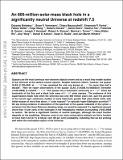An 800-million-solar-mass black hole in a significantly neutral Universe at a redshift of 7.5
Author(s)
Bañados, Eduardo; Venemans, Bram P; Mazzucchelli, Chiara; Farina, Emanuele P; Walter, Fabian; Wang, Feige; Decarli, Roberto; Stern, Daniel; Fan, Xiaohui; Davies, Frederick B; Hennawi, Joseph F; Simcoe, Robert A.; Turner, Monica Lisa; Rix, Hans-Walter; Yang, Jinyi; Kelson, Daniel D; Rudie, Gwen C; Winters, Jan Martin; ... Show more Show less
DownloadAccepted version (1.638Mb)
Publisher Policy
Publisher Policy
Article is made available in accordance with the publisher's policy and may be subject to US copyright law. Please refer to the publisher's site for terms of use.
Terms of use
Metadata
Show full item recordAbstract
Quasars are the most luminous non-Transient objects known and as a result they enable studies of the Universe at the earliest cosmic epochs. Despite extensive efforts, however, the quasar ULAS J1120 + 0641 at redshift z = 7.09 has remained the only one known at z > 7 for more than half a decade. Here we report observations of the quasar ULAS J134208.10 + 092838.61 (hereafter J1342 + 0928) at redshift z = 7.54. This quasar has a bolometric luminosity of 4 × 10 13 times the luminosity of the Sun and a black-hole mass of 8 × 10 8 solar masses. The existence of this supermassive black hole when the Universe was only 690 million years old-just five per cent of its current age-reinforces models of early black-hole growth that allow black holes with initial masses of more than about 10 4 solar masses or episodic hyper-Eddington accretion. We see strong evidence of absorption of the spectrum of the quasar redwards of the Lyman α emission line (the Gunn-Peterson damping wing), as would be expected if a significant amount (more than 10 per cent) of the hydrogen in the intergalactic medium surrounding J1342 + 0928 is neutral. We derive such a significant fraction of neutral hydrogen, although the exact fraction depends on the modelling. However, even in our most conservative analysis we find a fraction of more than 0.33 (0.11) at 68 per cent (95 per cent) probability, indicating that we are probing well within the reionization epoch of the Universe.
Date issued
2018Department
MIT Kavli Institute for Astrophysics and Space Research; Massachusetts Institute of Technology. Department of PhysicsJournal
Nature
Publisher
Springer Nature